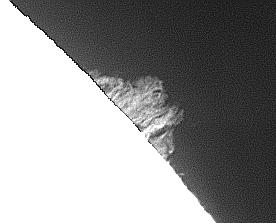Push Your Scope to the Max!
Jack Kramer
There's an interesting observation in the book The Star Lovers, by Robert S. Richardson: "...owing to advances in auxiliary instruments and photographic technique, the 100-inch telescope (at Mount Wilson) by 1947 had more than surpassed the gain in speed expected for the 200-inch telescope when originally planned in 1928." And in First Light, Richard Preston writes about a CCD camera, dubbed "4-shooter", built for the 200-inch at Mount Palomar. "When 4-shooter was installed in the Hale telescope, the Hale became at least one hundred times more powerful than it was when it was first built. In order to equal the light-gathering power of 4-shooter coupled to a two-hundred-inch mirror, George Ellery Hale would have had to build a telescope with a mirror at least one hundred and sixty-six feet across -- a mirror the size of a parking lot." Even very old telescopes are being resuscitated by technology. In 1996 the 30-inch refractor at the Allegheny Observatory was fitted with a new photometric device to help in the search for planets possibly orbiting other stars.
So here's an insight: If auxiliary instruments have so greatly expanded the range of observatory telescopes, what could they do for your own scope?
We generally think of our telescopes in terms of eye-to-eyepiece. But your eye will never become more sensitive to that faint transmitted light; in fact, as you get older, your eyesight only gets worse! And your present telescope isn't going to gather any more light than it was designed to gather. Here's where accessories can help in making use of whatever light your scope can grab.
Certainly, CCD imaging ranks high as one of the new frontiers. You've probably been amazed at some of the detailed CCD images acquired by amateurs, even from light-polluted surroundings. Moreover, image processing software provides an almost limitless range of control and enhancement of the existing image. As with all state-of-the-art processes, it seems that each month brings a new and better digital imaging product. Of course, this doesn't come cheaply. You can easily spend $600 for a very basic CCD camera and software (not counting the PC you'll need) and better equipment quickly ratchets up the cost. But with increased demand, prices will become more reasonable, just as the quality of the images will surely improve.
With the high-tech buzz of CCD imaging, use of film may seem like a mix of alchemy and insanity. But film isn't dead just yet. Conventional astrophotography may offer new worlds to conquer at a much lower cost. With a CCD, the imaging time is considerably less, but the small size of the CCD chip limits the size of the field that can be imaged. For large expanses, such as a star field or diffuse nebula, film is currently the only medium that can easily capture them. A good way to start is with just your SLR 35mm camera aimed at the sky. A 10-15 second exposure can be made without elongating the star images. Although many of the best photos are processed using complicated darkroom techniques, very good results have been achieved with relatively modest equipment and processing done at the local camera store.
Consider the Sun. A good solar filter generally is less than $100, depending on the size of your telescope. The next step in solar work might be a T-scanner or hydrogen alpha filter with which to view solar prominences. Of course, this becomes a bit pricey, starting at about $800. There's always at least one scope at Astrofest set up for viewing solar prominences. These are huge arching flames that leap from the surface of the Sun; they move so quickly that you can actually see them change if you're able to watch long enough. (But with the line of people waiting for a look, you probably won't have much time on a scope at a public display.) The photo below was taken with an H-Alpha filter by a local amateur, Gordon Garcia, of the Northwest Suburban Astronomers.

Still more fields await. Spectroscopy is one venture that doesn't have to be costly. (It was discussed in the July 1996 issue of NightTimes.)
For about $200, you can get an eyepiece with a finely-ruled reticle that facilitates estimating angular separations of objects or computing sizes of features such as craters on the moon and sunspots. Those with a mathematical inclination might be interested in calculating the height of lunar mountains and crater walls based on the lengths of shadows they cast on the surface of the moon, along with the altitude of the sun.
Even if your one and only instrument is a fairly small telescope, that doesn't mean you absolutely have to have a larger one. Maybe a larger scope is impractical for you or too costly. Consider upgrading rather than upsizing. Would a better mounting help? Or better eyepieces? If you're so inclined, apply new technology. Techniques that were once used only by professionals are now readily available to amateurs through the benefits of technology. And prices are quite reasonable, considering the high level of sophistication. Most of these accessories can be used with any telescope you own now or that you might purchase in the future.





